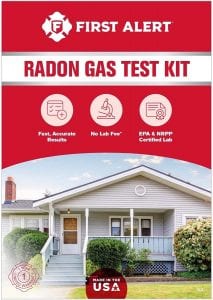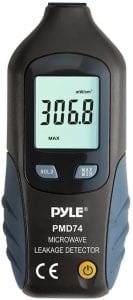The Best Radon Detector

Our Review Process
Don't Waste Your Money is focused on helping you make the best purchasing decision. Our team of experts spends hundreds of hours analyzing, testing, and researching products so you don't have to. Learn more.
Our Picks For The Top Radon Detectors
- 1. Airthings Corentium Digital Portable Radon Detector
- 2. First Alert RD1 EPA Certified Visual Alarm Radon Detector
- 3. Radon Eye RD200 Ecosense Electric Radon Detector
- 4. Health Metric NRPP-Certified Free Lab Radon Detector
- 5. SafetySiren Pro4 Continuous Monitoring Radon Detector
- 6. PANGAEA Premium Adjustable Radon Detector
- 7. RADEX RD1503+ 3-In-1 Geiger Counter Radon Detector
- 8. GQ GMC300EPlus Geiger Counting USB Radon Detector
- 9. Safety Siren HS71512 Pro Series3 EPA Evaluated Radon Detector
- 10. Elifecity Long-Lasting Low Consumption Radon Detector
- 11. Pyle Premium Microwave Radiation Detector Meter
Ideal for taking to new construction sites or areas without electricity, this detector is battery-powered. It generates results within 24 hours and you won't have any lab fees. It's ideal for long-term monitoring as radon levels fluctuate daily.
Travel ChoiceThis radon detector is highly portable, since it doesn’t need to be plugged into an outlet to use.
It's a good idea for every home to routinely have the radon levels checked, as radon is known for causing cancer. This kit is extremely easy to use and provides accurate test results within 72 hours of the company receiving your sample. Lab fees are included in the price, with the exception of New Jersey residents, who will need to pay a small fee.
Accurate ResultsIf you're looking for a radon test kit that delivers fast results, this model is your best bet.
Understanding your radon test results is simple with the app. This detector provides a reading within 10 minutes and reliable results with one hour of using. It updates readings every 10 minutes so you can have constant accurate data.
View Results on Your AppThis radon detector connects to an app on your phone so you can easily monitor and analyze results.
There's nothing more important than the health and safety of your family, which is why you'll want to have this radon detector on-hand. This accurate test only takes a few minutes of your time to set up. After it's run for two days, you'll mail it in to the lab for free to get your results. It's that easy!
Most EconomicalThis radon detector comes with a more affordable price tag than other models on the market.
Buying Guide
What is Radon?
Radon is a radioactive gas that is completely undetectable by humans because it is colorless and odorless. It is created when uranium or other radioactive materials decay and come out of rock formations, soil and specific building materials.
MORE: Here’s why testing your home can guard your family’s long-term health
Just because humans cannot detect radon doesn’t mean it doesn’t affect us, though. In fact, it is blamed for over 20,000 lung cancer deaths per year in the United States and is the second-leading cause of lung cancer, after cigarette smoking. Exposure to this gas over a long period of time can increase our chances of getting lung cancer by 50%.
Toxic exposure from radon is most common in the northern, midwestern and southwestern states. However, this gas can be found all over the country. This is why it’s imperative to test for it in your home. If you’re buying a new house, be sure to test for radon there before you finalize the purchasing agreement. According to the EPA, one out of every 15 homes in the United States has high levels of radon.
Radon Testing
There are a number of times when you should be testing for radon gas. If you’re buying or selling a home, always check for radon before finalizing any paperwork. If you’re buying a new build, ask whether radon-resistant construction materials have been used. You will also want to check if the building site has been tested for radon before. It’s also best to check for radon in workplaces as well.
A safe level of radon should be at 4 picocuries per liter (pCi/L) or lower. If it’s any higher than that, this means that you or your loved ones are at risk. Because radon is colorless and odorless, you need a special testing kit or detector to see whether it’s present.
Types of Radon Detectors
Two main types of devices detect radon: passive and active. A passive device is a manual gadget that doesn’t require electricity. It needs to be placed at the testing site for a specified period of time, after which is is away for analysis. An active device is an electrical gadget that monitors radon continuously. It’ll monitor the level of the gas over an extended period of time and can detect abnormalities or any unusual activity in the gas level. Active gadgets also deter any test interference so that you can be sure you’re getting accurate results. While active devices are more costly than passive ones, they are far more reliable as well.
What to Look For
- The most important element to consider when looking for a radon detector is its level of accuracy. You want to ensure that the device is able to deter any interference so you can get reliable results. If you don’t get accurate test results, you or your family could be in danger of getting sick from the toxic gas. In order to get a reliable result from short-term testing, be sure to keep your windows and doors closed aside from normal use. Do not conduct your test when there are heavy winds as that can alter the results. Also, you will need to place the device at least 20 inches above the floor. It should be on a stable surface where it’s away from drafts, heat, humidity or outside walls. Remember to carefully follow the device’s instructions and record the day and time you began your testing.
- Access to testing data is important if you want to analyze the results. Many electric radon detectors will have Bluetooth connectivity so that you can view the results on an app on your mobile phone. This makes it quick and easy to get results without waiting for a lab. In some cases, you can actually set up alarms on the app to go off if the radon reaches a toxic level. This is a good option for long-term testing.
- For many shoppers, portability is key. When you’re testing a new building site, you may not have access to an outlet to plug in your radon monitor. This is when a battery-powered gadget comes in handy. Not only is it highly flexible so you can place it anywhere in the home, but you can use it within areas where you don’t have any electricity.
- If you’re going to be moving the detector from place to place, also look at the size of the gadget. Some are small enough to fit in your pocket like a mobile phone, while others are big enough that you’ll need a bag to carry them around.
- Having a clear LCD display that shows you the radon levels can be helpful. In some devices, the display is located directly on the gadget itself. In others, you can view the results through a mobile phone app. Consider what is more convenient for you before making a purchase.
More to Explore
There are many myths surrounding radon, so it’s critical to be aware of the facts. Some people think that radon tests are difficult to conduct and take a lot of time. The truth is that electric radon detectors make testing easy and quick. In many cases, they have automatic alerts to tell you when the gas is at dangerous levels.
Another common myth is that radon only affects certain areas of the country or certain types of homes. That’s not the case, as high radon levels are found all over the country in every state. The type of home you have doesn’t affect your radon levels and neither does your neighbor’s radon levels. You can have issues with this gas whether your home is old or new, drafty or well-insulated. Radon levels are mainly affected by the geology around your home, along with the materials and processes used in constructing it.
Some people feel that there is no point in testing for radon if they have lived in their home for a long time. Even if no one has gotten ill from radon, it’s still vital to test for it. By doing so, you can reduce the risk of getting lung cancer.





















